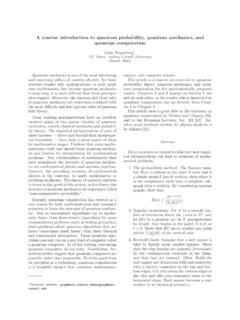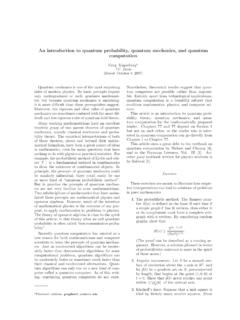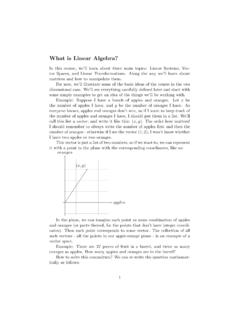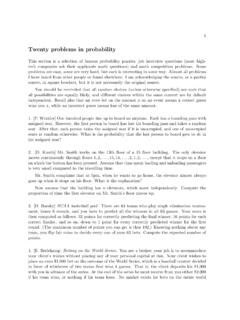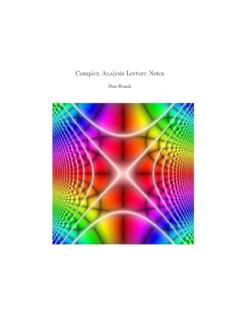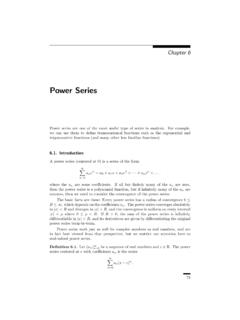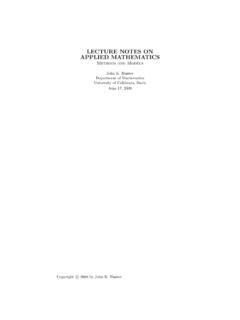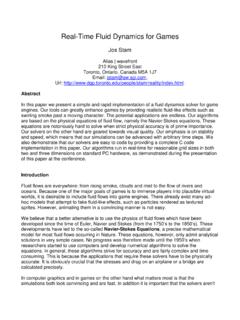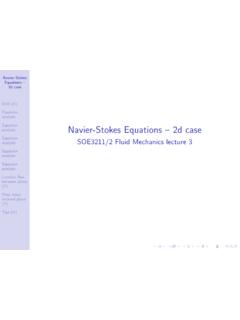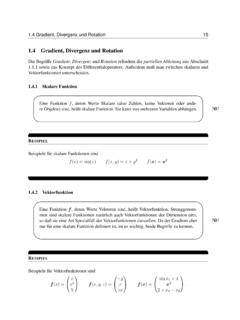Transcription of Derivation of the Navier–Stokes equations - Wikipedia, the ...
1 4/1/12 1:29 PMDerivation of the navier Stokes equations - Wikipedia, the free encyclopediaPage 1 of 17 of the navier Stokes equationsFrom Wikipedia, the free encyclopedia (Redirected from navier -Stokes equations / Derivation )The intent of this article is to highlight the importantpoints of the Derivation of the navier Stokesequations as well as the application and formulation fordifferent families of Basic assumptions2 The material derivative3 Conservation Conservation of Conservation of mass4 General form of the equations of motion5 Application to different Newtonian Compressible Newtonian Incompressible Newtonian Non-Newtonian Bingham Power-law fluid6 Stream function 2D flow in orthogonal coordinates7 The stress tensor8 Notes9 ReferencesBasic assumptionsThe navier Stokes equations are based on theassumption that the fluid, at the scale of interest, is acontinuum, in other words is not made up of discreteparticles but rather a continuous substance.
2 Another4/1/12 1:29 PMDerivation of the navier Stokes equations - Wikipedia, the free encyclopediaPage 2 of 17 assumption is that all the fields of interest likepressure, velocity, density, temperature and so on aredifferentiable, weakly at equations are derived from the basic principles ofconservation of mass, momentum, and energy. For thatmatter, sometimes it is necessary to consider a finitearbitrary volume, called a control volume, over whichthese principles can be applied. This finite volume isdenoted by and its bounding surface . The controlvolume can remain fixed in space or can move with material derivativeMain article: material derivativeChanges in properties of a moving fluid can be measuredin two different ways. One can measure a given propertyby either carrying out the measurement on a fixed pointin space as particles of the fluid pass by, or by followinga parcel of fluid along its streamline.
3 The derivative of afield with respect to a fixed position in space is called theEulerian derivative while the derivative following a movingparcel is called the convective or material material derivative is defined as the operator:where is the velocity of the fluid. The first term on theright-hand side of the equation is the ordinary Eulerianderivative ( the derivative on a fixed reference frame,representing changes at a point with respect to time)whereas the second term represents changes of aquantity with respect to position (see advection). This"special" derivative is in fact the ordinary derivative of afunction of many variables along a path following the fluidmotion; it may be derived through application of the 1:29 PMDerivation of the navier Stokes equations - Wikipedia, the free encyclopediaPage 3 of 17 example, the measurement of changes in windvelocity in the atmosphere can be obtained with the helpof an anemometer in a weather station or by mounting iton a weather balloon.
4 The anemometer in the first caseis measuring the velocity of all the moving particlespassing through a fixed point in space, whereas in thesecond case the instrument is measuring changes invelocity as it moves with the lawsThe navier Stokes equation is a special case of the(general) continuity equation. It, and associatedequations such as mass continuity, may be derived fromconservation principles is done via the Reynolds transport theorem, anintegral relation stating that the sum of the changes ofsome extensive property (call it ) defined over a controlvolume must be equal to what is lost (or gained)through the boundaries of the volume plus what iscreated/consumed by sources and sinks inside thecontrol volume. This is expressed by the followingintegral equation:where v is the velocity of the fluid and represents thesources and sinks in the fluid.
5 Recall that representsthe control volume and its bounding divergence theorem may be applied to the surfaceintegral, changing it into a volume integral:Applying Leibniz's rule to the integral on the left and then4/1/12 1:29 PMDerivation of the navier Stokes equations - Wikipedia, the free encyclopediaPage 4 of 17 all of the integrals:The integral must be zero for any control volume; thiscan only be true if the integrand itself is zero, so that:From this valuable relation (a very generic continuityequation), three important concepts may be conciselywritten: conservation of mass, conservation ofmomentum, and conservation of energy. Validity isretained if is a vector, in which case the vector-vectorproduct in the second term will be a of momentumThe most elemental form of the navier Stokes equationsis obtained when the conservation relation is applied tomomentum.
6 Writing momentum as gives:where is a dyad, a special case of tensor product,which results in a second rank tensor; the divergence ofa second rank tensor is again a vector (a first ranktensor)[1]. Noting that a body force (notated ) is a sourceor sink of momentum (per volume) and expanding thederivatives completely:Note that the gradient of a vector is a special case of thecovariant derivative, the operation results in second ranktensors[1]; except in Cartesian coordinates, it's importantto understand that this isn't simply an element by elementgradient. Rearranging and recognizing that :4/1/12 1:29 PMDerivation of the navier Stokes equations - Wikipedia, the free encyclopediaPage 5 of 17 leftmost expression enclosed in parentheses is, bymass continuity (shown in a moment), equal to that what remains on the left side of the equationis the convective derivative:This appears to simply be an expression of Newton'ssecond law (F = ma) in terms of body forces instead ofpoint forces.
7 Each term in any case of the navier Stokesequations is a body force. A shorter though less rigorousway to arrive at this result would be the application of thechain rule to acceleration:where . The reason why this is "less rigorous"is that we haven't shown that picking iscorrect; however it does make sense since with thatchoice of path the derivative is "following" a fluid"particle", and in order for Newton's second law to work,forces must be summed following a particle. For thisreason the convective derivative is also known as theparticle of massMass may be considered also. Taking (no sourcesor sinks of mass) and putting in density:4/1/12 1:29 PMDerivation of the navier Stokes equations - Wikipedia, the free encyclopediaPage 6 of 17 is the mass density (mass per unit volume), and is the velocity of the fluid. This equation is called themass continuity equation, or simply "the" continuityequation.
8 This equation generally accompanies theNavier Stokes the case of an incompressible fluid, is a constant andthe equation reduces to:which is in fact a statement of the conservation form of the equations ofmotionThe generic body force seen previously is madespecific first by breaking it up into two new terms, one todescribe forces resulting from stresses and one for"other" forces such as gravity. By examining the forcesacting on a small cube in a fluid, it may be shown thatwhere is the stress tensor, and accounts for otherbody forces present. This equation is called the Cauchymomentum equation and describes the non-relativisticmomentum conservation of any continuum thatconserves mass. is a rank two symmetric tensor givenby its covariant components:where the are normal stresses and shear tensor is split up into two terms:4/1/12 1:29 PMDerivation of the navier Stokes equations - Wikipedia, the free encyclopediaPage 7 of 17 is the 3 x 3 identity matrix and is the deviatoricstress tensor.
9 Note that the pressure p is equal to minusthe mean normal stress:[2]The motivation for doing this is that pressure is typically avariable of interest, and also this simplifies application tospecific fluid families later on since the rightmost tensor in the equation above must be zero for a fluid at that is traceless. The navier Stokes equationmay now be written in the most general form:This equation is still incomplete. For completion, onemust make hypotheses on the form of , that is, oneneeds a constitutive law for the stress tensor which canbe obtained for specific fluid families; additionally, if theflow is assumed compressible an equation of state will berequired, which will likely further require a conservation ofenergy to different fluidsThe general form of the equations of motion is not "readyfor use", the stress tensor is still unknown so that moreinformation is needed; this information is normally someknowledge of the viscous behavior of the fluid.
10 Fordifferent types of fluid flow this results in specific forms ofthe navier Stokes fluidMain article: Newtonian fluidCompressible Newtonian fluidThe formulation for Newtonian fluids stems from anobservation made by Newton that, for most fluids,4/1/12 1:29 PMDerivation of the navier Stokes equations - Wikipedia, the free encyclopediaPage 8 of 17 order to apply this to the navier Stokes equations ,three assumptions were made by Stokes:The stress tensor is a linear function of the fluid is a fluid at rest, must be zero (so thathydrostatic pressure results).Applying these assumptions will lead to: is the Kronecker delta. and are proportionalityconstants associated with the assumption that stressdepends on strain linearly; is called the first coefficientof viscosity (usually just called "viscosity") and is thesecond coefficient of viscosity (related to bulk viscosity).

